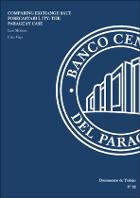Comparing exchange rate forecastability: the Paraguay case
Documento de Trabajo; N° 22
Fecha de publicación
2019-07-01Idioma del documento
engAbstract
Forecasting exchange rates is a very difficult task. Since Meese and Rogoff’s (1983) results showed that no model could outperform a driftless random walk in predicting exchange rates, there have been many papers which have tried to find some forecasting methodology that could beat the random walk, at least for certain forecasting periods. In particular, Wright (2008) introduced Bayesian Model Averaging as a tool to forecast exchange rates and Lam et al (2008) compared Bayesian Model Averaging and three structural models to a benchmark model (the random walk), both studies obtaining positive results. Also, Carriero et al (2009) found positive results using a Bayesian Vector Auto-regression model. The present paper is a small contribution to the same type of literature by comparing Purchasing Power Parity, Uncovered Interest Rate, Sticky Price, Bayesian Model Averaging, and Bayesian Vector Auto-regression models to the random walk benchmark in forecasting exchange rates between the Paraguayan Guarani and the US Dollar, the Brazilian Real and the Argentinian Peso. Forecasts are evaluated under the criteria of Root Mean Square Error, Direction of Change, and the Diebold-Mariano statistic. The results indicate that in shorter horizon forecasting BMA and BVAR can perform better but other models outperform the random walk at longer horizons.
Palabras clave
Keywords
Colecciones
 Esta obra está bajo licencia internacional Creative Commons Reconocimiento-NoComercial 4.0.Este documento ha sido depositado por parte de el(los) autor(es) bajo la siguiente constancia de depósito
Esta obra está bajo licencia internacional Creative Commons Reconocimiento-NoComercial 4.0.Este documento ha sido depositado por parte de el(los) autor(es) bajo la siguiente constancia de depósito

